Last updated: March 10, 2023
We bought two horses at the same time; both were yearlings and fed identical diets. One horse is fit, and the other is carrying too much weight. So I want to change the type of hay I’m feeding the heavy horse to reduce its weight while still maintaining optimal health for training purposes. So, what type of hay should I choose?
The best hay to feed overweight horses is mature grass hay, such as Timothy. Timothy hay is high in fiber and lower in calories than other hays, but it still has good nutritional value. Timothy will help improve an obese horse’s metabolism, bowel movements, and overall health.
Not all types of hay are equal, as they have different nutritional values. So, choosing the right type for your horse’s dietary needs is essential to manage your horse’s health and avoiding problems. This is especially true when you have an overweight horse.
The Best Type Of Hay For Overweight Horses
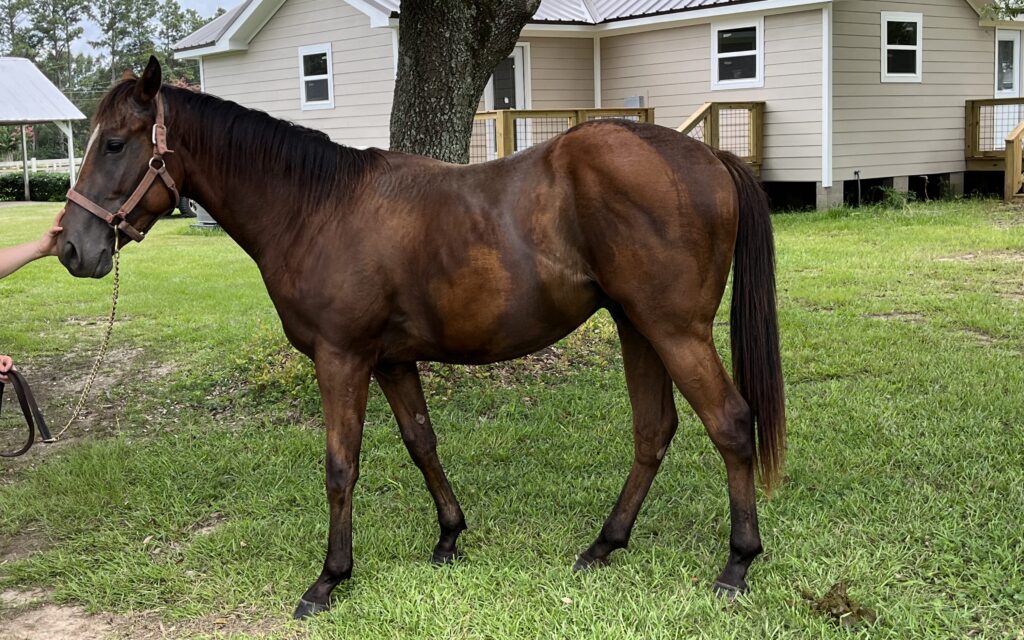
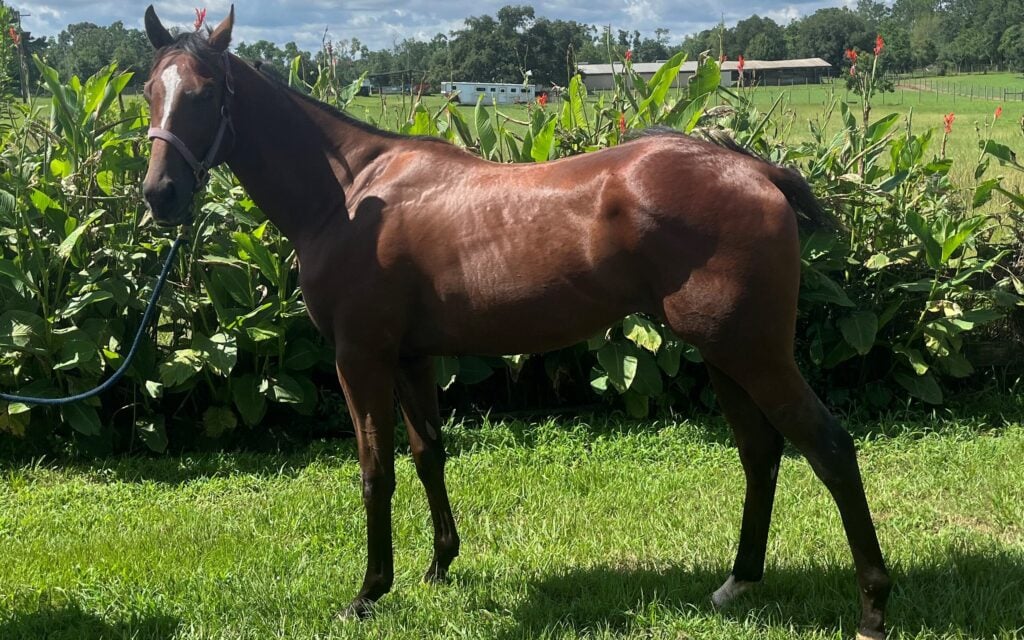
Above is a picture of the two horses I mentioned in the introduction. Both are two-year-old Thoroughbreds who eat the same diet. However, we had to back off on our training a little on the first one because he was staying too heavy.
When a horse is overweight, it can affect all aspects of its well-being, and it is prone to injury. We worm them regularly, so that’s not the issue. So why is he keeping a belly?
A horse might be overweight because it has metabolic issues like insulin resistance, or it might consume more calories than it spends. Some horses love to eat and can be lazy or not sufficiently exercised. It is best to manage and prevent obesity and future health issues, starting with diet.
Mature Timothy hay is considered the best choice for overweight horses because of its nutritional ratios and lower calorie content. It can be fed to most horses with varying activity levels because it is filling and palatable to most horses. Timothy hay is one of the most favored choices for horse hay in the United States.
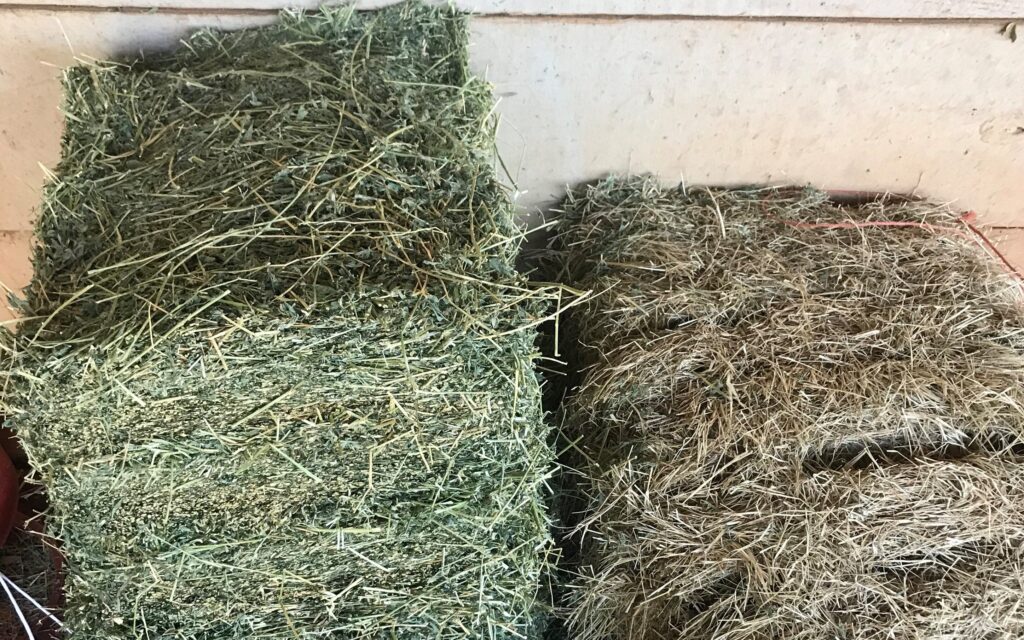
How To Determine Which Hay Type Is Best For Your Horse
Hays differ in their nutritional values and benefits, while horses will vary in their dietary needs. Therefore, choosing the best forage mix for your horse is important to ensure its optimal health and well-being.
You can consider the following when choosing the best hay option for your horse:
- Your horse’s weight,
- Your horse’s energy expenditure,
- Your horse’s health issues, and
- Your horse’s age.
Your Horse’s Weight
The hay you choose will depend on your horse’s weight. If it is overweight, you will need to choose low-calorie hay that is nutritional and filling. Conversely, calorie and nutrient-rich hay is recommended if the horse is underweight.
Your Horse’s Energy Expenditure
Horses will differ in their activity levels. Therefore, choosing hay with a calorie content that matches their energy expenditure is essential, ensuring the correct protein balance. For example, an idle horse should not eat excessive alfalfa hay, nor should a hard-working horse on a hot day.
Your Horse’s Health Issues
Your horse’s health issues or vulnerabilities should be considered when choosing hay. Some examples include obesity, insulin resistance, colic, and laminitis, and hays with a high carbohydrate content should be minimized in such instances.
Moldy hay should be avoided in all cases, and dusty hay should not be fed to horses with breathing problems. Broodmares will need a protein-rich forage but should not eat fescue because of its predisposition to host endophyte fungus.
Your Horse’s Age
It is best to choose hay that suits the age of your horse. For example, soft, nutrient- and calorie-rich hay should be fed to young and energetic foals or older horses struggling to chew or keep weight.
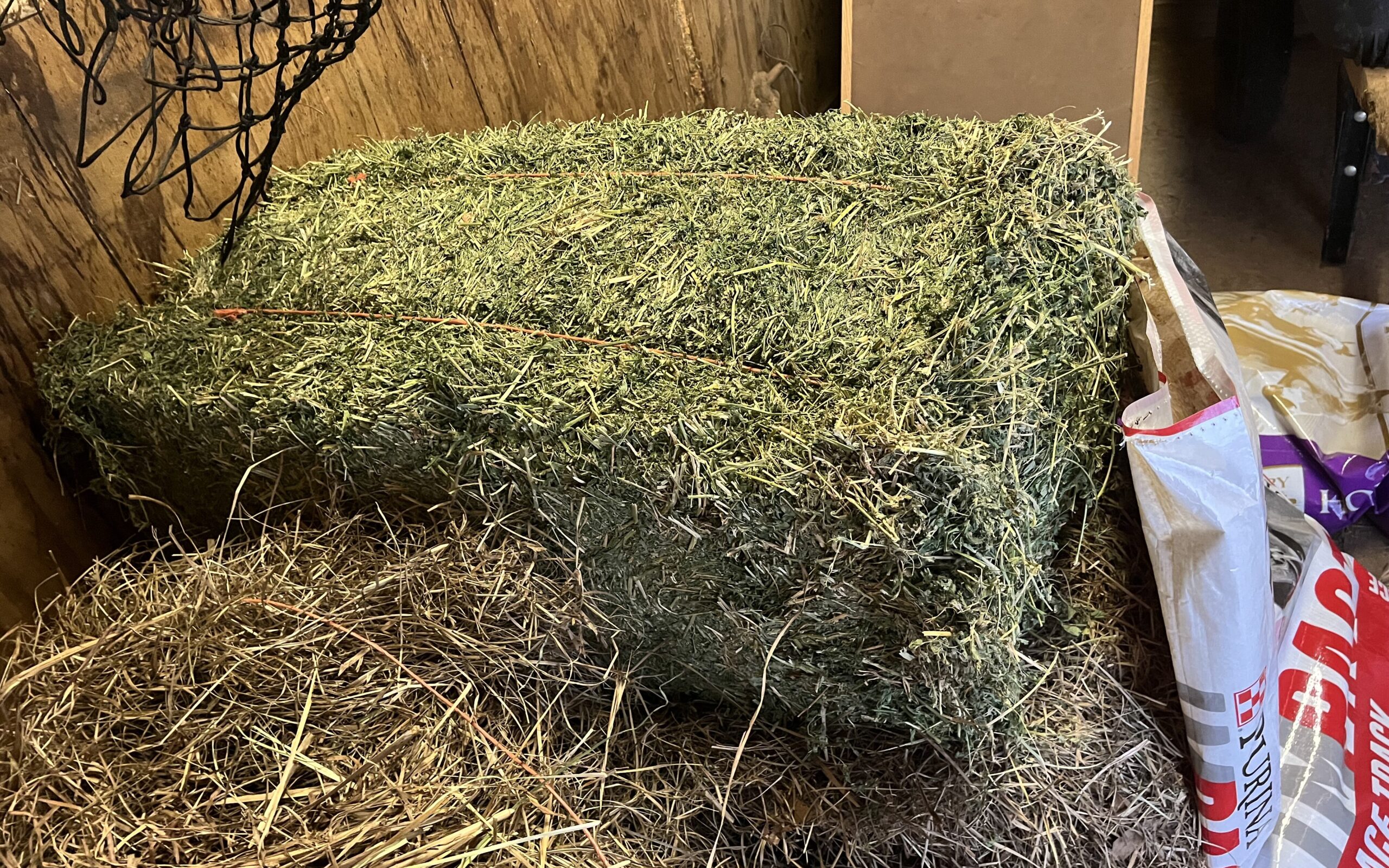
Benefits Of Feeding A Horse Hay That Is Suited To Its Weight
Feeding suitable hay to your horse has many benefits for the horse and horse owner. These include the following:
- The horse will have regular and healthy bowel movements.
- The horse will have a healthy, shiny coat.
- There will be fewer gut issues relating to colic, ulcers, and general gastric upsets.
- There will be fewer issues arising with breathing issues or joint problems.
- Fewer health issues mean fewer vet visits.
- The hay will help the horse reach its desired weight plus have the correct nutrient and calorie content.
- The horse will have the right energy and nutritional intake for its activity levels, avoiding obesity or malnutrition.
The Types Of Hay That Are Available On The Market
Hay for livestock can be classified under three categories: grass, legume, and cereal hay. On average, the amount of hay a horse will consume daily is equivalent to two percent of its body mass. Therefore, it is vital to ensure the forage you give to your horse is suitable according to its energy expenditure and health requirements.
- Grass hay, the most popular feed for horses, includes bromegrass, orchardgrass, ryegrass, fescue, Timothy, Bermuda, and bluegrass.
- Legume hay includes calorie-rich alfalfa and clover.
- Cereal hay can come from wheat, oat, and barley plants.
Each hay differs in its nutritional value. Most hays will provide different protein, calcium, vitamins, and fiber ratios. All hay fed to horses should be high-quality and well-stored to keep its nutritional value and minimize the growth of mold, which could make a horse ill if consumed.
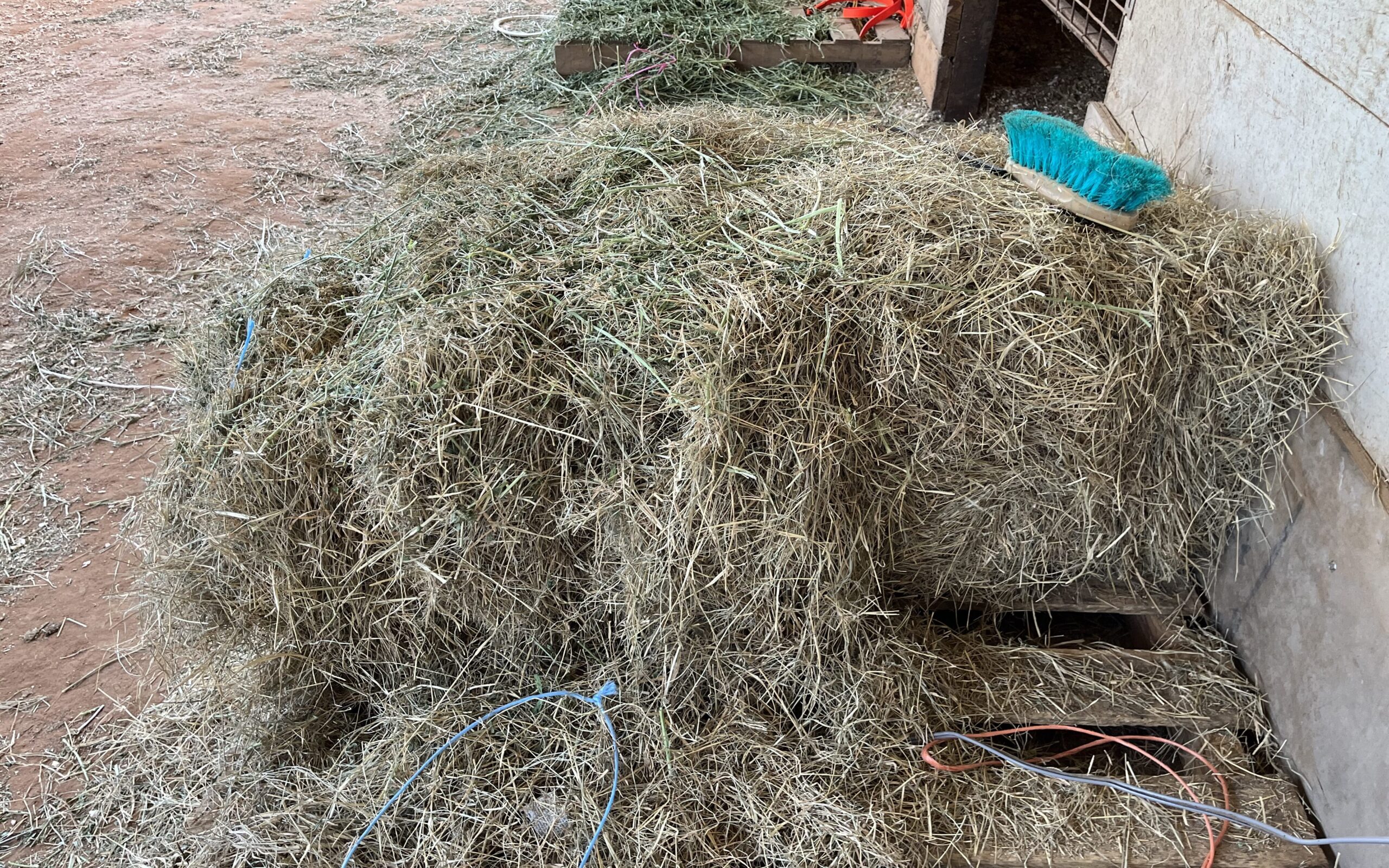
Grass Hays
Grass hays are best to use as feed for overweight horses. Specifically, Timothy hay harvested when the grass was mature. Grass hays are lower in calories than the other types of hay but meet most horses’ dietary and satiety needs.
Grass hays can be divided into two groups: cool-season and warm-season. Cool-season grass hays are generally tastier for horses due to their higher sugar content. They include ryegrass, bromegrass, orchardgrass, fescue, wheatgrass, and bluegrass. Warm-season grass hays include teff and Bermuda grass.
Below is a table comparing the commonly sold grass hays available on the market.
| Common Grass Hays on the Market | |
|---|---|
| Name Of Hay | Description |
| Timothy | One of the most popular choices of hay in the U.S.Considered the best hay to give to most horses.Fine texture. Contains about 8% protein. A good option for horses with various energy or work levels.Tasty for horses and easily digestible.High in nutrients and fiber. Satisfies appetite without surplus calories. Best hay for overweight, protein-sensitive, or colic-prone horses. |
| Orchardgrass | A good choice for older horses or those with digestive problems.Rich in digestible fiber. Contains 10 – 12% crude protein. Not sustainable for a hard-keeping horse or pregnant mare and would need to be supplemented. |
| Ryegrass | Offers good nutrition for most horses. Horses find the fine texture palatable. |
| Fescue | Low in sugar, palatable, and a practical choice for horse owners. It can be suitable for horses with insulin problems or overweight. Not suitable for pregnant mares due to potential endophyte fungal infection. It needs to be tested for fungus before feeding to horses. |
| Bromegrass | Smooth grass with more leaves and fewer stems.Nutritionally like Timothy grass.A soft hay ideal for older horses. A good choice for young or old horses with moderate activity levels.Palatable source of fiber. Higher sugar levels may not be ideal for overweight or insulin-resistant horses. |
| Bluegrass | Low-yielding grass from Kentucky. Highly nutritious and palatable.Good hay for most horses. |
| Bermuda grass | Also known as coastal hay. Usually, the cheapest hay on the market. A good nutrition source for most horses. It contains 6 – 11% protein. A common and practical choice for most horses. Lower in protein than other grasses. |
Legume Hays
Legume hay can have up to triple the amount of calcium than grass hay. Alfalfa hay is the most popular legume hay for horses, with clover hay being the second most popular. Legume hays are higher in protein, Vitamin A, calcium, and digestible energy than grass hays.
When choosing legume hay, it is essential to check the color and leaf-to-stem ratio of the bales, as those are quality and nutrient value indicators.
| Common Legume Hays on the Market | |
|---|---|
| Name Of Hay | Description |
| Alfalfa | The most popular type of legume hay for horses. High protein (15 – 20%), calcium, and fiber. Recommended for horses with high-energy needs, e.g., show horses. It can be used for underweight horses or those suffering from muscular problems. Not recommended for overweight horses. Not suitable for horses working hard in hot weather due to elevated heat generation from protein metabolism – it can lead to dehydration and overheating. |
| Clover | Different varieties include white, red (most popular), crimson, landino, and alsike. It has high levels of protein, nutrients, calcium, and fiber. Clover hay is a good choice for working horses. Clover hay is not recommended for overweight horses. It can cause some horses to drool excessively due to mycotoxin’s presence. |
Cereal Hays
Cereal hays are less commonly used as forage for horses. If cereal hay is harvested and the grains are removed, it becomes straw that has little to no nutritional value. Oat hay harvested at the soft-dough stage of its life cycle is the most popular type of cereal hay for horses. It is highly nutritious and digestible when harvested at the correct time.
| Most Common Cereal Hay on the Market | |
|---|---|
| Name Of Hay | Description |
| Oat | Best harvested at the soft dough stage.High sugar content.Not recommended for insulin-resistant horses. High in protein and nutrients, It can cause bloating due to high protein levels. |

How To Switch Your Horse Over To A Different Type Of Hay
When introducing new hay to your horse’s forage, it is essential to do so gradually to reduce the risks of gastric upset. This is because the new hay will change the pH balance in the cecum of a horse. The bacteria that ferment food in a horse’s hindgut are sensitive to changes in diet, mainly when a horse eats a particular forage regularly.
When introducing new hay, a horse owner should gradually introduce the new hay by mixing it with their usual hay. You can increase the new hay ratio in increments over 7 to 10 days until the new hay makes up the desired percentage of the forage.
In addition, it is recommended that a high-quality equestrian probiotic is supplemented into the horse’s diet during this time. The probiotic will help to balance the pathogens and unwanted microbes while creating a natural microbiome in the horse’s gut. I also like to use a hay net to slow their consumption when switching hay.
Why are some horses overweight?
Not all horses are created equal; some can eat whatever they want without gaining weight, while others need careful management. The same can be said about people. I know a guy who eats like a horse and never gains a pound, while another friend – just has to see a plate of food and will gain weight.
Why does this happen? A horse might be overweight because it has metabolic issues like insulin resistance. This means that the horse’s body has trouble using sugar from food to give it energy. As a result, the horse might eat more than usual to get enough energy.
Another reason why horses might become overweight is if they consume more calories than they spend. For instance, if the horse spends most of its day standing around in a stable, it will burn fewer calories than if it spends its day running around in a field. So if the horse eats the same amount of food each day, it will likely gain weight over time.
Thankfully, there are ways to help an overweight horse lose weight safely. My mom and dad put me on a strict diet and exercise plan, and eventually, I lost all the excess weight. It was hard work, but now I feel so much better!
Horse breeds that are prone to gaining weight are ponies, draught horses, and cobs. However, many horses are considered obese in modern times. This is because they feed more on fortified pastures intended for fattening other livestock, like cattle, instead of free-roam grazing on naturally occurring vegetation. Additionally, many recreational horses are not exercised enough.

The Importance Of Keeping Your Horse At A Healthy Weight
It is best to keep your horse at a healthy weight to avoid health issues. Both underweight and overweight horses will have gut problems that can affect their mental, muscular, and joint health. A horse at a healthy weight is less likely to have heart or lung problems. Its joints and feet will not be under excessive pressure due to obesity or malnutrition.
By keeping track of your horse’s body condition, you can monitor changes and swiftly act if you notice a problem developing. Doing so can improve your horse’s overall health and well-being and prevent secondary issues from cropping up.
Conclusion
Many horses today are prone to obesity due to excessive calorie intake and insufficient exercise. To reduce the weight of an obese horse, the best type of hay is timothy grass hay because it is low in calories yet meets most horses’ nutrient and satiety needs.
FAQs
How do I get my fat horse to lose weight?
The best way to get your horse to lose weight is by gradually transitioning it to a lower-calorie diet and increasing its level of exercise. Overweight horses take time to get fit, so be patient and don’t expect quick results.
Does soaking hay help horses lose weight?
Yes, soaking hay can help horses lose weight. This was confirmed by at least one study of obese horses. The reason for the weight loss isn’t clear, but one theory is that the added water makes the horses feel fuller and eat slower.
References
- https://equusmagazine.com/news/all-about-horse-hay/
- https://aaep.org/horsehealth/obesity
- https://alfalfa.ucdavis.edu/+symposium/2010/files/talks/CAS29_RodiekOptimizingHayHorses.pdf
- https://extension.umn.edu/horse-health/caring-overweight-horse
- https://practicalhorsemanmag.com/health-archive/right-hay-for-your-horse-28938/
- https://www.agdaily.com/crops/list-of-types-of-hay-found-us/
- https://www.hobbyfarms.com/all-hay-is-not-equal-choose-your-livestocks-carefully/

About the Author: Miles Henry
Lifelong Horseman | Racehorse Owner | Published Author
Miles Henry brings over 25 years of hands-on experience training and owning Thoroughbred racehorses. Raised with Quarter Horses and Appaloosas, he’s spent a lifetime learning from horses—on the track, in the barn, and in the field. Today, he runs a small but successful racing stable in Louisiana and shares real-world insights on HorseRacingSense.com, helping horse owners, fans, and bettors navigate the sport with confidence.
📚 Books: View Miles’s books on Amazon »
🎧 Podcast Guest: Animal Tales Ep. 32 |
YouTube Interview
📩 Newsletter: Sign up for racing tips and horse care advice »
🔗 Follow Miles:
Twitter |
Facebook |
YouTube

